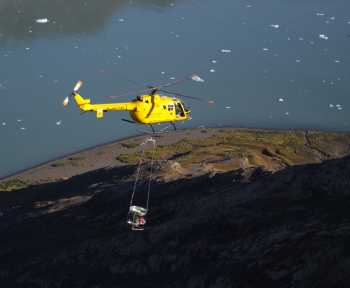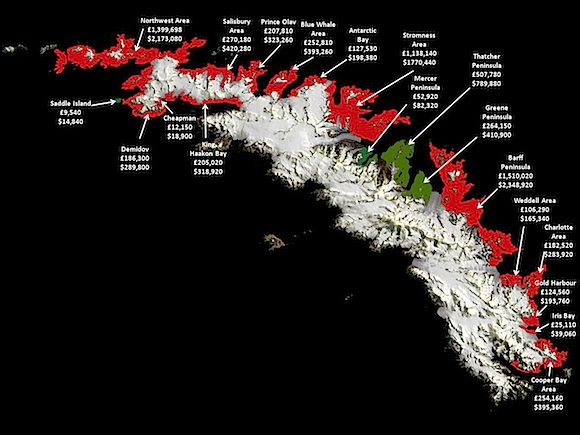Unlike for the Macquarie Island Pest Eradication Project (MIPEP) when many seabirds died (click here), very few seabirds have been found dead after Phase One of the South Georgia Habitat Restoration Project. Last year in April 12 800 ha of South Georgia (Islas Georgias del Sur)* was covered with poison bait dropped from helicopters, the largest area treated so far globally, in an effort to rid it of introduced Norway or Brown Rats Rattus norvegicus.

A helicopter spreads poison bait over South Georgia (Islas Georgias del Sur)*
Phootgraph courtesey of Tony Martin
A report by the South Georgia Heritage Trust Advisory Panel on Non-target Mortality reveals only 153 birds were found dead after the bait drop, compared to 2190 over two years of baiting a similar area on Macquarie. Most (113) were South Georgia Pintails Anas georgica georgica.
No ACAP-listed species were found dead, again in contrast to Macquarie, where 720 (one third) of the birds known to have been killed were giant petrels Macronectes spp., mainly Northerns M. halli. The advisory panel's report considers the reasons for this difference, one of which is that European Rabbit Oryctolagus cuniculus carcasses on Macquarie attracted scavenging birds, resulting in secondary poisoning. Fortunately South Georgia is rabbit-free.
To access the Project News newsletter of the South Georgia Habitat Restoration Project click here. The latest issue (No. 9 of January 2012) brings the news that birds, including Subantarctic Skuas Catharacta antarctica, South Georgia Pintails and the endemic South Georgia Pipit Anthus antarcticus, are returning to the treated area (with the first two species breeding) and after 10 months there are still no signs of rats, leading to cautious optimism being expressed by the Project's Director, Tony Martin.
Phase 2 of the restoration project is now set to take place over 2013 and 2014, with 17 separate areas totalling 80 000 ha still to be treated before the island can be declared rodent-free. A massive and expensive task, one that can be helped by those willing to sponsor a hectare (click here).

South Georgia (Islas Georgias del Sur)*
The four green areas were treated with poison bait in 2011 (Phase 1); the red areas are to be treated in 2013 and 2014
Selected References:
South Georgia Heritage Trust 2011. Operational Plan for the Eradication of Rodents from South Georgia: Phase 2 Second draft - 17 Oct 2011. South Georgia Heritage Trust. 61 pp.
South Georgia Heritage Trust 2011. Environmental Impact Assessment for the Eradication of Rodents from the Island of South Georgia. 18 September 2011. South Georgia Heritage Trust. 89 pp.
South Georgia Heritage Trust Advisory Panel on Non-target Mortality 2011. Assessment of Impacts of Non-target Mortality during Phase 1, and Recommendations on Timing and Approaches to Mitigation in Phase 2. Unpublished report to South Georgia Heritage Trust, October 2011. 21 pp.
With thanks to Professor Anthony Martin, Director, South Georgia Habitat Restoration Project, South Georgia Heritage Trust for information and photographs.
John Cooper, ACAP Information Officer, 2 February 2012
*A dispute exists between the Governments of Argentina and the United Kingdom of Great Britain and Northern Ireland concerning sovereignty over the Falkland Islands (Islas Malvinas), South Georgia and the South Sandwich Islands (Islas Georgias del Sur y Islas Sandwich del Sur) and the surrounding maritime areas.

 English
English  Français
Français  Español
Español